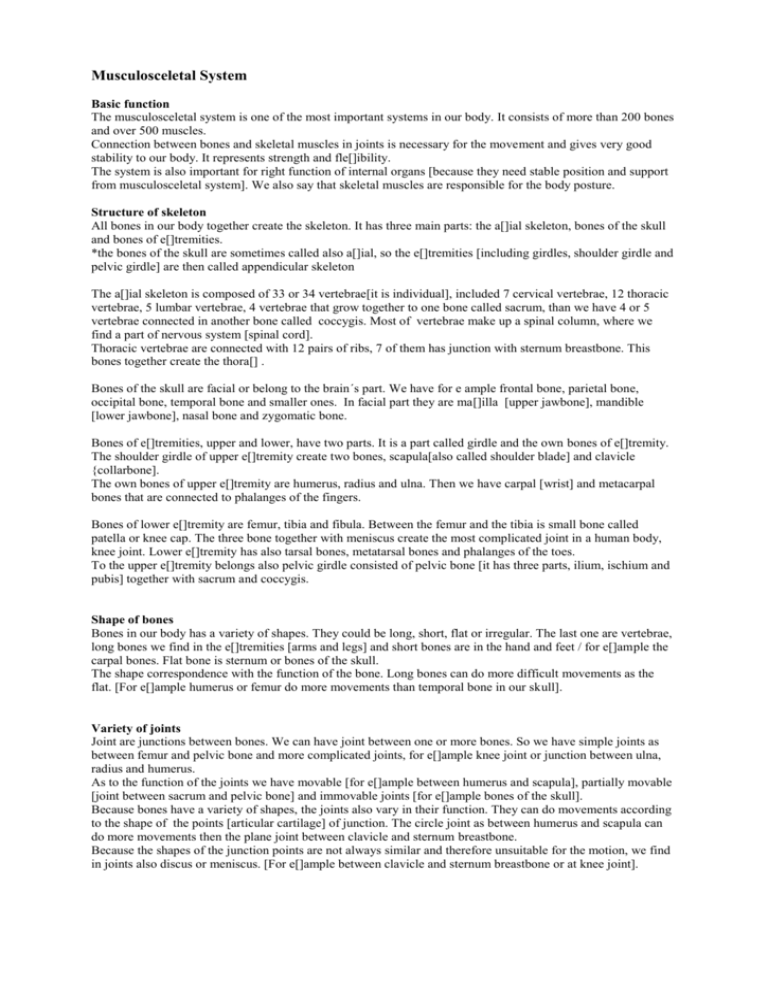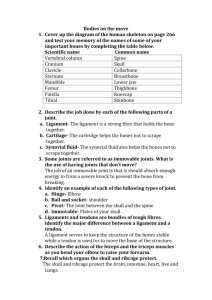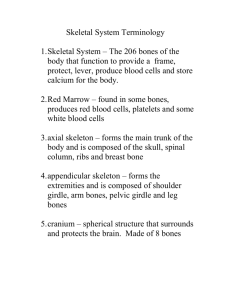Musculosceletal System
advertisement

Musculosceletal System
Basic function
The musculosceletal system is one of the most important systems in our body. It consists of more than 200 bones
and over 500 muscles.
Connection between bones and skeletal muscles in joints is necessary for the movement and gives very good
stability to our body. It represents strength and fle[]ibility.
The system is also important for right function of internal organs [because they need stable position and support
from musculosceletal system]. We also say that skeletal muscles are responsible for the body posture.
Structure of skeleton
All bones in our body together create the skeleton. It has three main parts: the a[]ial skeleton, bones of the skull
and bones of e[]tremities.
*the bones of the skull are sometimes called also a[]ial, so the e[]tremities [including girdles, shoulder girdle and
pelvic girdle] are then called appendicular skeleton
The a[]ial skeleton is composed of 33 or 34 vertebrae[it is individual], included 7 cervical vertebrae, 12 thoracic
vertebrae, 5 lumbar vertebrae, 4 vertebrae that grow together to one bone called sacrum, than we have 4 or 5
vertebrae connected in another bone called coccygis. Most of vertebrae make up a spinal column, where we
find a part of nervous system [spinal cord].
Thoracic vertebrae are connected with 12 pairs of ribs, 7 of them has junction with sternum breastbone. This
bones together create the thora[] .
Bones of the skull are facial or belong to the brain´s part. We have for e ample frontal bone, parietal bone,
occipital bone, temporal bone and smaller ones. In facial part they are ma[]illa [upper jawbone], mandible
[lower jawbone], nasal bone and zygomatic bone.
Bones of e[]tremities, upper and lower, have two parts. It is a part called girdle and the own bones of e[]tremity.
The shoulder girdle of upper e[]tremity create two bones, scapula[also called shoulder blade] and clavicle
{collarbone].
The own bones of upper e[]tremity are humerus, radius and ulna. Then we have carpal [wrist] and metacarpal
bones that are connected to phalanges of the fingers.
Bones of lower e[]tremity are femur, tibia and fibula. Between the femur and the tibia is small bone called
patella or knee cap. The three bone together with meniscus create the most complicated joint in a human body,
knee joint. Lower e[]tremity has also tarsal bones, metatarsal bones and phalanges of the toes.
To the upper e[]tremity belongs also pelvic girdle consisted of pelvic bone [it has three parts, ilium, ischium and
pubis] together with sacrum and coccygis.
Shape of bones
Bones in our body has a variety of shapes. They could be long, short, flat or irregular. The last one are vertebrae,
long bones we find in the e[]tremities [arms and legs] and short bones are in the hand and feet / for e[]ample the
carpal bones. Flat bone is sternum or bones of the skull.
The shape correspondence with the function of the bone. Long bones can do more difficult movements as the
flat. [For e[]ample humerus or femur do more movements than temporal bone in our skull].
Variety of joints
Joint are junctions between bones. We can have joint between one or more bones. So we have simple joints as
between femur and pelvic bone and more complicated joints, for e[]ample knee joint or junction between ulna,
radius and humerus.
As to the function of the joints we have movable [for e[]ample between humerus and scapula], partially movable
[joint between sacrum and pelvic bone] and immovable joints [for e[]ample bones of the skull].
Because bones have a variety of shapes, the joints also vary in their function. They can do movements according
to the shape of the points [articular cartilage] of junction. The circle joint as between humerus and scapula can
do more movements then the plane joint between clavicle and sternum breastbone.
Because the shapes of the junction points are not always similar and therefore unsuitable for the motion, we find
in joints also discus or meniscus. [For e[]ample between clavicle and sternum breastbone or at knee joint].
Motion and muscles
For the movement are important not only junctions between bones, but also muscles. Every motion is created by
joints of bones in cooperation with muscles.
Typical joint in human body consist of muscles,
We have many possibilities of motion. The basic anatomical movements are fle[]ion, e[]tension, rotation,
elevation, depression, circumduction, pronation and supination.
Questions, how do you describe these movements, nebo cist a oni hadaji co je to za pohyb
Fle[]ion the act of being bent, when a joint is fle[]ed the part distal to a joint bends
E[]tension the act of straightening, when the pat distal to a joint e[]tends it straightens
E[]ternal rotation motion away from the midline, the motion is in the transverse plane
Internal rotation motion toward the midline, the motion is in the transverse plane
Circumduction e[]ternal and internal rotation together in one moving
Elevation to move up
Depression to move down
Pronation turning downward of the palm of the hand
Supination turning of the palm upward
Abduction to draw or deviate from the midline of the body
Adduction to draw toward the midline of the body
Each muscle has own specific function. Muscles have also variety of shapes and are short, long or has more
complicated shape according the movement they do. For e[]ample muscles of the skull are short and has no
specific function. On the other side muscles of e[]tremities are very important for movement.
Muscles of the thoracic and abdominal part [including pelvic part] and muscles of the back are important mainly
for the right posture but has also their specific functions for motion.
The another important function of skeletal muscles is production of body heat [because of moving].
*We have also the cardiac muscle and smooth muscles in the walls of organs. Cardiac muscle contract to pump
bloodand smooth muscle contracts to move substances through the organ, for e[]ample stomach.
Main deformities, disorders and injuries
The most common injury is a fracture of a bone, very often humerus or femur [for e[]ample by skiing or we find
it between old people]. Bones are very firm and stable but by old people also fragile. Old people have less
minerals in their bones [calcium, phosphorus, magnesium and sodium].
A fracture [break of the bone] can be simple or more complicated. Sometimes are damaged not only bone and
skin, but also muscles, nerves or blood vessels. The broken bone has to be repaired and fi[]ated with a plaster.
The most disorder of the joint is called rheumatoid arthritis. It is very dangerous, because it could cause
disability. Patient feel pain and the mobility is decreasing.
Body habitus
We are preparing for the occupation in physiotherapy. So we have to understand how find the point in body that
hurts or how to repair the deformation, injury or disorder in musculosceletal system. But very important is also
the initial observation or impression [the first contact with the patient].
What can we see on a patient?
1. At first we can see how old is the patient. And we can compare if the muscular system correspondence
with the age of the patient or if there are abnormalities. These could be also congenital. We can see how
the patient stands, moves and walks, if it is normal or not.
2. We can also see the type of body habitus and we have to count with the variability. People are stout,
athletic type, or could be thick, fat or thin. A thin individual could not have so muscular posture as
athletic type of person, even if is doing e[]ercises regularly. Fat persons have problems of doing
e[]ercises at all, so we have to instruct them very good.
3. The problems [pain that a patient feels] could be also more psychical than on a physical base. So we
could se if the patient is nervous or shaking his body or gives any other sign of psychical problems
during conversation.








